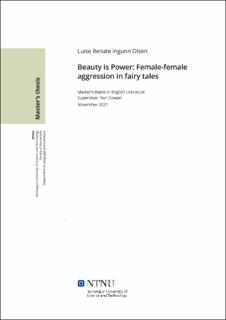| dc.description.abstract | This dissertation aims to explore female-female aggression in Western fairy tales, and the cause and underlying motivations behind female characters’ abusive and violent acts. Looking at traditional tales by well-known authors such as Charles Perrault and the Grimm brothers, it becomes clear that the concept of beauty is ever-present in their stories, and that it is the beautiful and young heroine who becomes the victim of the jealous and aggressive villainess. Physical appearance is undoubtedly connected to many aspects regarding female aggression, rivalry and violence in the tales. Thus, the focus has been directed towards understanding the impact beauty and youth, or the lack thereof, have on female relationships, even between mothers and daughters. In order to understand how and why the characters are created the way they are, it has been of great importance to keep in mind the cultural and personal background of the tales’ different narrators and adaptors. In particular the influences which cause the traditional heroines and villainesses to observe strict pattern of either being passively obedient and desirable young maidens, or the ugly and hostile stepfamily which abuses and challenges the “good girl”. This dissertation has also examined the prevailing reward and punishment system for female characters, and what they must be and do in order to be awarded a “happy ending”. In addition to the well-known classics by for example the Grimm brother, contemporary adaptations by authors such as Angela Carter and Neil Gaiman are used to illustrate the different cultural and ideological influences of tales such as “Cinderella”, “Little Snow White” and “Briar Rose”. Their feminist and postmodern perspectives challenge the traditional stories by providing new angles and insight into the villainess’ point of view, exposing the disconcerting sides of patriarchal ideology found in the popular tales many have grown up with. | |
